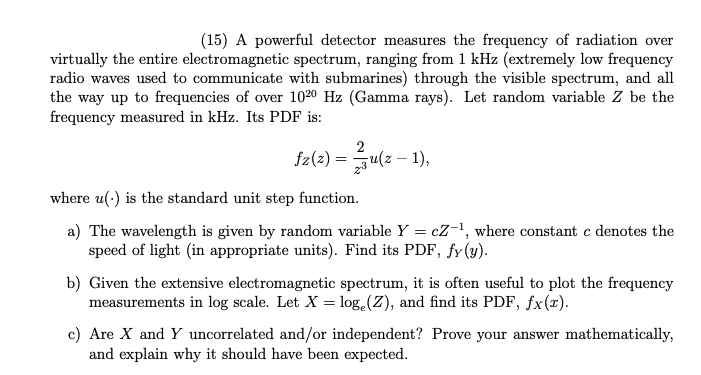(15) A powerful detector measures the frequency of radiation over virtually the entire electromagnetic spectrum, ranging from 1 kHz (extremely low frequency radio waves used to communicate with submarines) through the visible spectrum, and all the way up to frequencies of over 1020 Hz (Gamma rays). Let random variable Z be the frequency measured in kHz. Its PDF is: 2 fz(z) = u(z − 1), where u() is the standard unit step function. a) The wavelength is given by random variable Y = cZ-¹, where constant c denotes the speed of light (in appropriate units). Find its PDF, fy(y). b) Given the extensive electromagnetic spectrum, it is often useful to plot the frequency measurements in log scale. Let X = loge (Z), and find its PDF, fx(x). c) Are X and Y uncorrelated and/or independent? Prove your answer mathematically, and explain why it should have been expected.
(15) A powerful detector measures the frequency of radiation over virtually the entire electromagnetic spectrum, ranging from 1 kHz (extremely low frequency radio waves used to communicate with submarines) through the visible spectrum, and all the way up to frequencies of over 1020 Hz (Gamma rays). Let random variable Z be the frequency measured in kHz. Its PDF is: 2 fz(z) = u(z − 1), where u() is the standard unit step function. a) The wavelength is given by random variable Y = cZ-¹, where constant c denotes the speed of light (in appropriate units). Find its PDF, fy(y). b) Given the extensive electromagnetic spectrum, it is often useful to plot the frequency measurements in log scale. Let X = loge (Z), and find its PDF, fx(x). c) Are X and Y uncorrelated and/or independent? Prove your answer mathematically, and explain why it should have been expected.
Algebra & Trigonometry with Analytic Geometry
13th Edition
ISBN:9781133382119
Author:Swokowski
Publisher:Swokowski
Chapter5: Inverse, Exponential, And Logarithmic Functions
Section5.6: Exponential And Logarithmic Equations
Problem 64E
Related questions
Question
Clearly hand write,
As soon as possible

Transcribed Image Text:(15) A powerful detector measures the frequency of radiation over
virtually the entire electromagnetic spectrum, ranging from 1 kHz (extremely low frequency
radio waves used to communicate with submarines) through the visible spectrum, and all
the way up to frequencies of over 1020 Hz (Gamma rays). Let random variable Z be the
frequency measured in kHz. Its PDF is:
2
fz(z) = u(z − 1),
where u() is the standard unit step function.
a) The wavelength is given by random variable Y = cZ-¹, where constant c denotes the
speed of light (in appropriate units). Find its PDF, fy(y).
b) Given the extensive electromagnetic spectrum, it is often useful to plot the frequency
measurements in log scale. Let X = loge (Z), and find its PDF, fx(x).
c) Are X and Y uncorrelated and/or independent? Prove your answer mathematically,
and explain why it should have been expected.
Expert Solution
This question has been solved!
Explore an expertly crafted, step-by-step solution for a thorough understanding of key concepts.
This is a popular solution!
Trending now
This is a popular solution!
Step by step
Solved in 4 steps with 4 images

Recommended textbooks for you

Algebra & Trigonometry with Analytic Geometry
Algebra
ISBN:
9781133382119
Author:
Swokowski
Publisher:
Cengage

Linear Algebra: A Modern Introduction
Algebra
ISBN:
9781285463247
Author:
David Poole
Publisher:
Cengage Learning

Trigonometry (MindTap Course List)
Trigonometry
ISBN:
9781337278461
Author:
Ron Larson
Publisher:
Cengage Learning

Algebra & Trigonometry with Analytic Geometry
Algebra
ISBN:
9781133382119
Author:
Swokowski
Publisher:
Cengage

Linear Algebra: A Modern Introduction
Algebra
ISBN:
9781285463247
Author:
David Poole
Publisher:
Cengage Learning

Trigonometry (MindTap Course List)
Trigonometry
ISBN:
9781337278461
Author:
Ron Larson
Publisher:
Cengage Learning